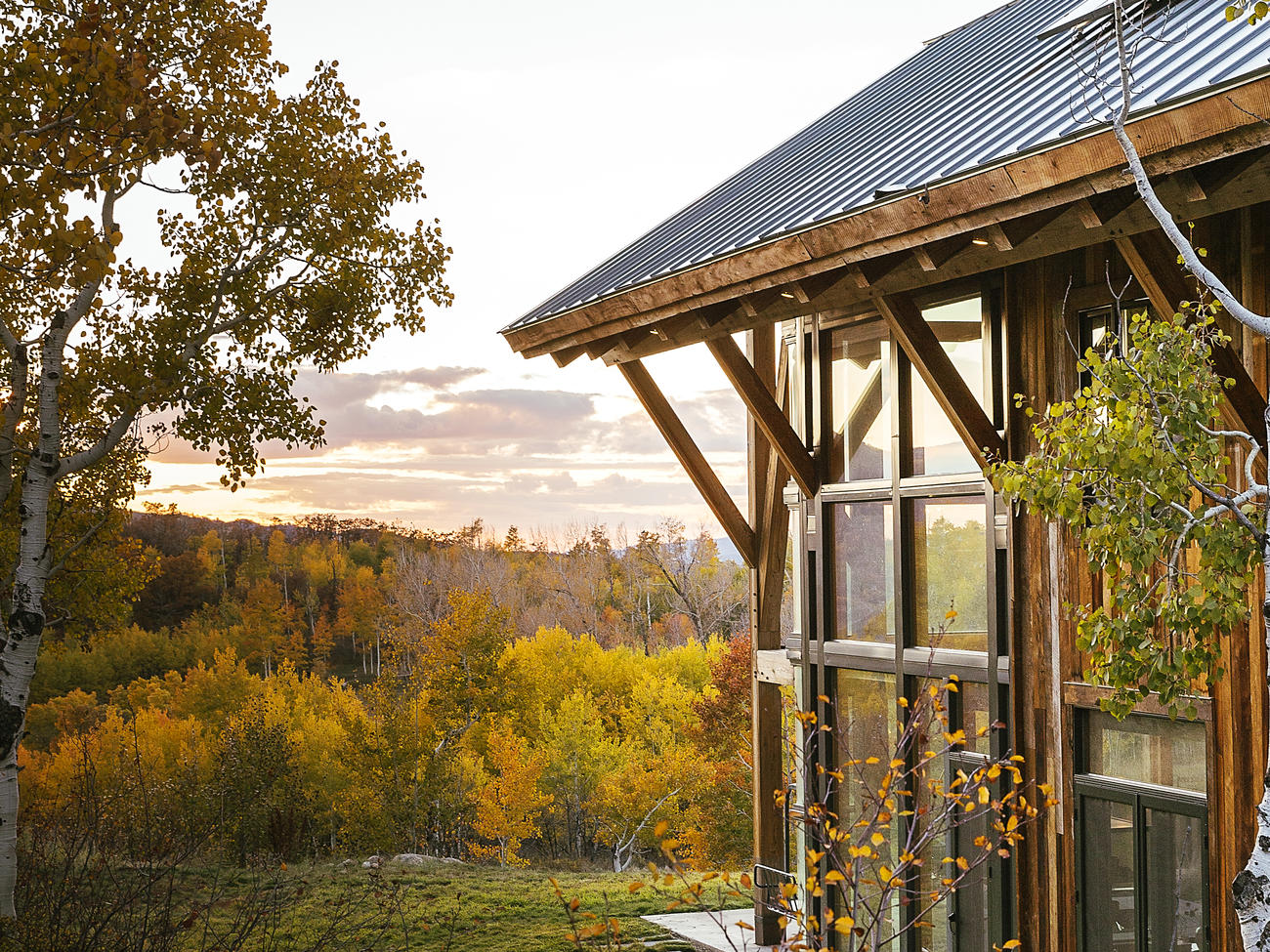
Eco-Friendly Roofing
Top off your home with an earth-friendly solution, from green roofs to solar panels.

Homes built with energy efficiency in mind should include roofing material that is durable, low maintenance, and reflective. White or light-colored roofs reduce heat gain, keeping the overall temperature of the roof low so that heat isn’t transferred into the house.
Many eco-friendly homes have standing-seam metal roofs, which are low maintenance and light in color and also reflect the sun. Photovoltaic panels are easily clipped on, or film panels can be nestled between the seams. Metal is also good for collecting rainwater to reuse in the landscape. Other options include light-colored concrete, clay, or stone tiles; wood shakes; asphalt composition; or tar and gravel for flat roofs. Asphalt composition shingles are a popular choice because of their low price point and long life. If you select them, choose a light color that helps reflect the sun rather than the typical black or gray.
Flat roofs are common on adobe houses and those with a modern architectural style. When architect Eric Corey Freed builds a flat-roofed house, he uses polyiso (polyisocyanurate) foam as an insulator and finish material in one. Look for products by manufacturers that use pentane as the blowing agent rather than an ozone-depleting material. “You end up with a 2- to 6-inch-thick mass that, once hardened, creates a super-insulated, leak-proof roof. There are no seams, which is good from a maintenance standpoint,” Freed says.
Ask your builder to include a radiant barrier in the attic. This material, which can come laminated to the back of OSB roof decking or attached on-site, blocks approximately 90 percent of a roof deck’s radiant heat from entering the attic, making your living space much cooler. The radiant barrier works in conjunction with the air intakes and exhaust in the roof, allowing heat from the roof’s surface to escape quickly so it isn’t pushed down into the attic. “Also include a waterproofing membrane under the roofing material as an extra layer of insurance against leaks,” advises architect Michelle Kaufmann.
Green Roofs
Plants blossoming atop the roof of a home are an increasingly common sight to behold. Beyond the attractive qualities of a house that blends in with its natural surroundings, a green roof has many environmental benefits.
To create a green roof, you can apply a waterproof membrane, lightweight soil, and low-maintenance plants, or you can assemble a modular green-roof system that clicks together and contains everything from roof protection to seedlings. Extensive green roofs, which feature low groundcovers and 2 to 4 inches of soil, are more common than intensive green roofs, which require several feet of soil and look more like a natural landscape with a variety of plant heights. The plant choices for green roofs depend on your climate and average rainfall, but in general they should be spreading plants that have a high drought tolerance. Sometimes an irrigation system is required, which adds to the weight of the roof and the cost of installation.
Up to 90 percent of a typical rainfall can be absorbed by a green roof, which reduces the drainage requirements of the surrounding building and the amount of rainwater that picks up pollutants on its way to storm drains. A water-retention layer sits on top of the waterproof membrane and under the plant, soil, and drainage layers of a green roof. Before installing a system, consult a builder or engineer to make sure your roof can handle the extra weight from heavy rainfall.
Green roofs will make the interior of the building more comfortable and will save you money on maintenance and energy costs. The waterproof membrane installed beneath the soil and plants protects the roof surface from ultraviolet rays and temperature fluctuation, thereby greatly increasing the life span of the roof and providing energy savings by keeping the house cooler. Green roofs also make the inside of the house quieter and lower the air temperature surrounding the house.
“Urban heat island” is a term that describes overheating in urban and suburban areas compared with rural areas because of the extensive paved and built surfaces that attract heat. Increased temperatures result in more air-conditioning and electricity usage, which is harmful to the environment. Cities like Chicago have paid close attention to this phenomenon and have implemented incentive programs for buildings that install green roofs in the city to counteract the effect.
Solar Panels
Nothing screams “environmentally conscious home” quite like a swath of solar panels on the roof. If you live in a large and otherwise energy-efficient home but need to use your air-conditioning for many months out of the year, or if you have more electric than gas-run appliances, installing solar panels is a smart decision. Some people who are marginal in this cost equation choose to swap gas-powered appliances for electric ones just to make the system worthwhile. It’s possible to have your entire home run on solar panels in this case. Many areas offer tax credits and rebate programs that can reduce your upfront costs.
Beyond cost savings, harnessing and using your own energy rather than relying on conventional power plants means less coal is being burned to produce electricity, and that has wide-reaching environmental benefits. If you gather enough energy, you can even send electricity back to the utility company, getting a credit on future bills just by sitting in your home and letting it bask in the sunlight. But if you generate more energy than you use in an entire year, the utility company generally does not cut you a check, so it’s not a money-making scheme, just a money-saving opportunity.
Installation Issues
When you call a solar company about installation, you will be asked many questions, including how much you generally spend on electricity.
If you seem like a good candidate for solar, the company will do a site evaluation. Your roof needs to be strong enough to support the panels, and new enough that you won’t have to dismantle the system to redo the roof anytime soon. Installers like to see south-facing roofs without surrounding large trees, but any direction other than north can still work well enough to be worth it. The panels need to get a minimum of four hours of direct sunlight per day. It’s possible to install the panels on a garage, on an arbor, or even on the ground if your home’s roof isn’t appropriate.
Be sure you buy or lease a solar energy system from a reputable dealer that uses proven, high-quality equipment. A good solar company will also monitor the performance of the system, supply you with data, perform any maintenance needed, and offer a warranty on parts and installation.
